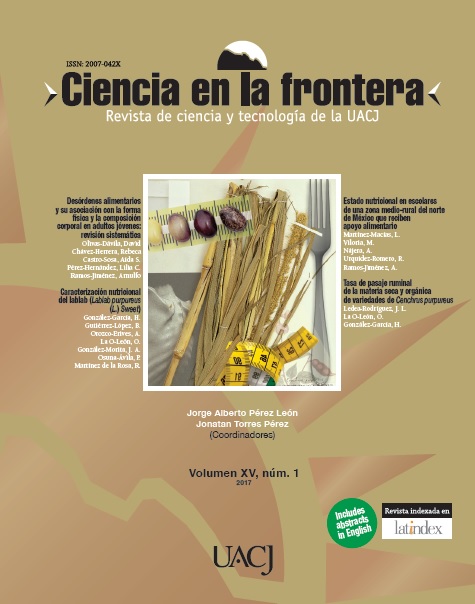Nutritional status in schoolchildren in a rural area of northern Mexico who receive food support
Keywords:
child nutrition, school feeding, nutrition programs and policiesAbstract
The purpose was to study the impact of an annual food support program on the nutritional status of schoolchildren. Two hundred and forty-six children enrolled in elementary schools with very low economic resources in a mid-rural area of northern Mexico participated; schools with kitchens where foods are prepared for sale among schoolchildren. In one school the sale of the breakfasts was symbolic (two pesos or none, financed school) in the others at low cost (6-15 pesos, self-financed schools). School menus, weight, height, body mass index (BMI) and age of the children were recorded. There is more proportion of children with malnutrition, overweight and obesity in self-financing schools. Children in funded schools are on average within their ideal weight, height and BMI for their age, while those in self-funded schools are within 0.40 standard deviations (SD) of their ideal nutritional status. Children in nutritionally funded schools had lower rates of malnutrition than children in self-funded schools.References
Bain, L. E., Awah, P. K., Geraldine, N., Kindong, N.
P., Siga, Y., Bernard, N., Tanjeko, A. T. (2014).
Malnutrition in Sub–Saharan Africa: burden,
causes and prospects. Pan Afr Med J, 15(1),
-9.
Barquera, S., Rivera-Dommarco, J., Gasca-García,
A. (2001). Políticas y programas de alimentación
y nutrición en México. Salud Pública
Mex, 43(5), 464-477.
Blumenthal, S. J., Hoffnagle, E. E., Leung, C. W.,
Lofink, H., Jensen, H. H., Foerster, S. B., et al.
(2014). Strategies to improve the dietary quality
of Supplemental Nutrition Assistance Program
(SNAP) beneficiaries: an assessment
of stakeholder opinions. Public Health Nutr,
(12), 2824-2833.
De la Peña, G. (1999). Territorio y ciudadanía étnica
en la nación globalizada. Desacatos, 1,
-16. Disponible en: http://www.scielo.org.
mx/pdf/desacatos/n1/n1a6.pdf Acceso el 26
de septiembre del 2017.
De Onis, M., Blössner, M., Borghi, E. (2010). Global
prevalence and trends of overweight and
obesity among preschool children. Am J Clin
Nutr, 92(5), 1257-1264.
De Onis, M., Blössner, M., Borghi, E. (2012). Prevalence
and trends of stunting among preschool
children, 1990–2020. Public Health
Nutr, 15(01), 142-148.
Dev, D. A., McBride, B. A., Fiese, B. H., Jones, B.L.,
Cho (2013). Behalf of the Strong Kids Research
Team, H. Risk factors for overweight/
obesity in preschool children: an ecological
approach. Child obes, 9(5), 399-408.
Gibson, R. S. Principles of nutritional assessment
(2nd ed.): Oxford University Press, USA;
908 p.
Hall, K. D., Sacks, G., Chandramohan, D., Chow, C.
C., Wang, Y. C., Gortmaker, S. L., Swinburn,
B. A. (2011). Quantification of the effect of
energy imbalance on bodyweight. Lancet,
(9793), 826-837.
Hilmers, A., Chen, T. A., Dave J. M., Thompson, D.,
Cullen, K. W. (2014). Supplemental Nutrition
Assistance Program participation did not help
low income Hispanic women in Texas meet
the dietary guidelines. Prev Med, 62, 44-48.
Instituto Nacional de Salud Pública (Mex). Encuesta
Nacional de Salud y Nutrición 2012.
Disponible en: http://ensanut.insp.mx Acceso
el 20 marzo del 2016.
Kong, A., Odoms-Young, A. M., Schiffer, L. A., Kim,
Y., Berbaum, M. L., Porter, S. J., et al. (2014).
The 18-month impact of special supplemental
nutrition program for women, infants, and
children food package revisions on diets of
recipient families. Am J Prev Med, 46(6), 543-
Lagarde, M., Haines, A., Palmer, N. (2007). Conditional
cash transfers for improving uptake
of health interventions in low-and middle-income
countries: a systematic review. JAMA,
(16), 1900-1910.
Leung, C. W., Blumenthal, S. J., Hoffnagle, E. E.,
Jensen, H. H., Foerster, S. B., Nestle, M., et
al. (2013). Associations of food stamp participation
with dietary quality and obesity in children.
Pediatrics, 131(3), 463-472.
Luca, A. C., Iordache, C. (2013). Obesity–a risk factor
for cardiovascular diseases. Rev Med Chir
Soc Med Nat Iasi, 117(1), 65-71.
Mariz, L. S., Enders, B. C., Santos, V. E., Tourinho,
F. S., Vieira, C. E. (2015). Causes of infantile-
juvenile obesity: reflexions based on the
theory of Hannah Arendt. Text Context Nursing,
(3), 891-897.
Muzzo, S. (2003). Crecimiento normal y patológico
del niño y del adolescente. Rev Chil Nutr,
(2), 92-100.
National Health and Nutrition Examination Survey.
Center for Disease Control and Prevention
Growth Charts for the United States, 2000.
Disponible en: http://www.cdc.gov/nchs/
data/erratas/growthcherrata.pdf Acceso el
marzo del 2016.
Pérez-Lizaur, A. B., Gonzalez-Palacios, B., Castro-
Becerra, A. L. Sistema Mexicano de Alimentos
Equivalentes. 4ª ed. FNS. México; 2014. 160 p.
Prospera (Mex). Objetivo, visión y misión. Gobierno
de la República. 2014. Disponible en:
https://www.prospera.gob.mx/swb/es/
PROSPERA2015/home Acceso el 20 marzo
del 2016.
Ramírez-López, E., Grijalva-Haro, M. I., Valencia,
M. E., Ponce, J. A., Artalejo, E. (2005). Impacto
de un programa de desayunos escolares en
la prevalencia de obesidad y factores de riesgo
cardiovascular en niños sonorenses. Salud
Pública Mex, 47(2), 126-33.
Rytter, M. J., Kolte, L., Briend, A., Friis, H., Christensen, V. B. (2014). The immune system in children with malnutrition—a systematic review. PLoS One, 9(8), e105017. DOI: 10.1371/journal.pone.0105017.
Secretaría de Educación Pública (Mex). Mi escuela PEC. Actualización, Enero 2014. Disponible en: http://www.gob.mx/sep/acciones-y-programas/mi-escuela-pec?state=published Acceso el 20 marzo del 2016.
Secretaría de Salud (Mex). Norma Oficial Mexicana NOM-031-SSA2-1999, Para la atención a la salud del niño. Disponible en: http://www.salud.gob.mx/unidades/cdi/nom/031ssa29.html Acceso el 20 marzo del 2016.
UNICEF. State of the World’s Children 1998. Oxford: Oxford University Press, 1998. Disponible en: http://www.unicef.org/sowc/archive/ENGLISH/The%20State%20of%20the%20World’s%20Children%201998.pdf Acceso el 20 marzo del 2016.
Waterlow, J. C., Buzina, R., Keller, W., Lane, J. M., Nichaman, M. Z. et al. (1977). The presentation and use of height and weight data for comparing the nutritional status of groups of children under the age of 10 years. Bull World Health Organ, 55, 489-98.
Word Health Organization. Global child deaths down by almost half since 1990. WHO, UNICEF, World Bank Group, UN-DESA Population Division joint news release. New York 2013 Disponible en: http://www.who.int/mediacentre/news/releases/2013/child_mortality_causes_20130913/en/ Acceso el 9 abril del 2016.
Word Health Organization. Obesity and overweight. Fact sheet N°311 January 2015. Disponible en: http://www.who.int/mediacentre/factsheets/fs311/es/ Acceso el 20 marzo del 2016.


